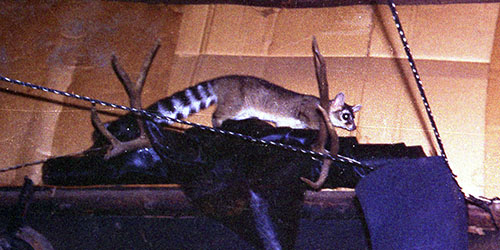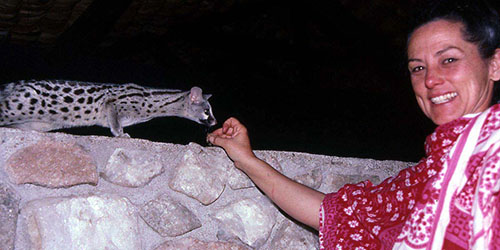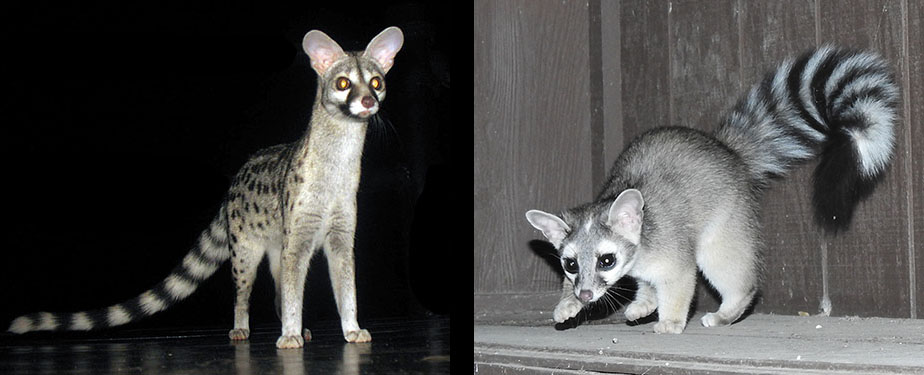I am fascinated by the way environments shape animals that have different lineages. Two animals that fit this look-alike-but-different description are Ringtails in the Americas and Genets in Africa.
Here are pictures of these two look-alikes. Both the ringtail and the genet are deft, busy nocturnal creatures with pointy noses and big eyes. Their ringed tails are as long as their bodies. They are both about the size of a small cat. There are some differences: Ringtails have white around their eyes, brown fur, while the genet has spots all over its body.
The ringtail and the genet behave similarly. By night they run up and down trees hunting for small prey: fruit, insects, lizards, birds and rodents. By day they hide in holes or brush. Both slinky creatures are hyper alert, adept at keeping out of the way of their main predators that include snakes, owls, and big cats.
Their way of life demands the ability to see well in the dark, to climb, balance, snatch and be willing to eat most anything. These qualities mean a compact body, short legs, big eyes, a sensitive nose and ears, plus a long balancing tail. Ringtails and genets are mostly solitary animals, mate briefly and the young stay with mom for a short time until they can hunt for themselves.
Ringtails and genets look alike and act alike but their most recent common ancestor was 60 million years ago, when the “cat-like” carnivores (Feliformia) separated from the “dog-like” Caniformia. From the latter stock evolved the Procyonids in the Americas. The Procyonids today include ringtails, racoons, coatis and kinkajous. About 10 million years ago, ringtails and raccoons diverged from one another. That means they separated longer ago than humans did from chimpanzees. The ringtail is Arizona’s state mammal and lives in many parts of the desert, places we can glimpse and appreciate them.
The genets are part of a group called the Viverrids that evolved from Feliformia stock in the Old World. They include genets, civets, and linsangs – all mysterious scented creatures that are among the most poorly known carnivores. The similarities between ringtails and genets are due to adaptation to similar environments. This is called convergent evolution and is fairly common in nature. Examples include hummingbirds in the Americas and the similar but different lineage of sunbirds in Africa. Also sharks, a fish, contrasted with a dolphin, a mammal, but both streamlined swimmers. Even plants converge in appearance when they have to cope with similar habitats. Consider the spiny desert cacti of the Americas and the spiny euphorbias of Africa. Very different genetic backgrounds but both groups needing to conserve water and protect themselves from animals in hot climates.

Ringtails introduced themselves to me when I was a young placer gold miner in the mountains of California. When they visited our camp, hardened miner types melted in their presence. We loved to lure them in, feed and play with them, but left them wild and free. I got hooked on these creatures, called Bassaricus astutus.
Later when I went to Africa, I was struck by the similar genet, Genetta genetta, who also came into buildings to be fed, yet remaining wild and free too. Ringtails and genets are my “totem” animals. I identify with them. I too am a visitor to the modern busy world. I feed and play here but long to escape back to the wild.

A friend who ran a lodge in the southern Serengeti where genets were abundant gave me the nickname Genetta. It fits me better than Bassaricus. My Genetta name reminds me of both these graceful convergent creatures of the two different continents that have shaped me.


4 replies on “Ringtail and Genet”
Thanks for the info. I grew up in the rugged hill country of central Texas. I was told Ringtails and Civet Cats were the same thing. I saw many Ringtails, but just one Civet Cat. I strongly suspicioned they were different, but didn’t know for sure until just now.
Glad we could clear this up. I wonder what your ‘civet’ was? Civets are African and Asian and do not occur in USA at all as far as we know. Could it have been an Ocelot?
‘civet’ is one of the colloquial names of ringtails owing to their similarity to their old world lookalikes, kinda like the trees we yanks call ‘cedars’ relative to the ‘true cedars’ of the old world
Just yesterday a friend recently told me that one night, very late, he was laying down on a ridge along the Northern California coast watching the stars and dozed off. He woke up to a ringtail (a member of the raccoon family) checking him out and quite close to him! They have an interesting history in CA, including snuggling with miners on cold nights way back in the day. The picture he sent me reminded me of the genets I saw when I was at the Ndutu Lodge in 2011 (I was immediately lovestruck). What a delight to find this post not only for comparing the two, but also for bringing me back to memories of an unforgettable trip. Thank you Jeannette.